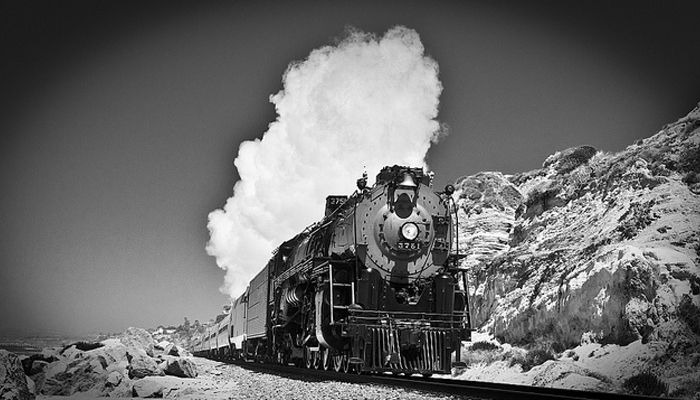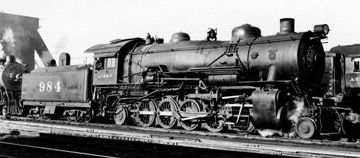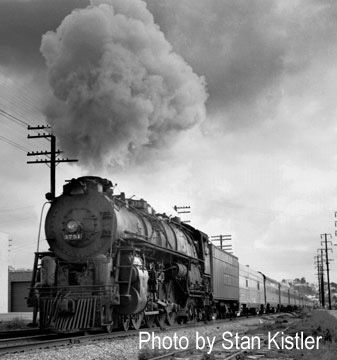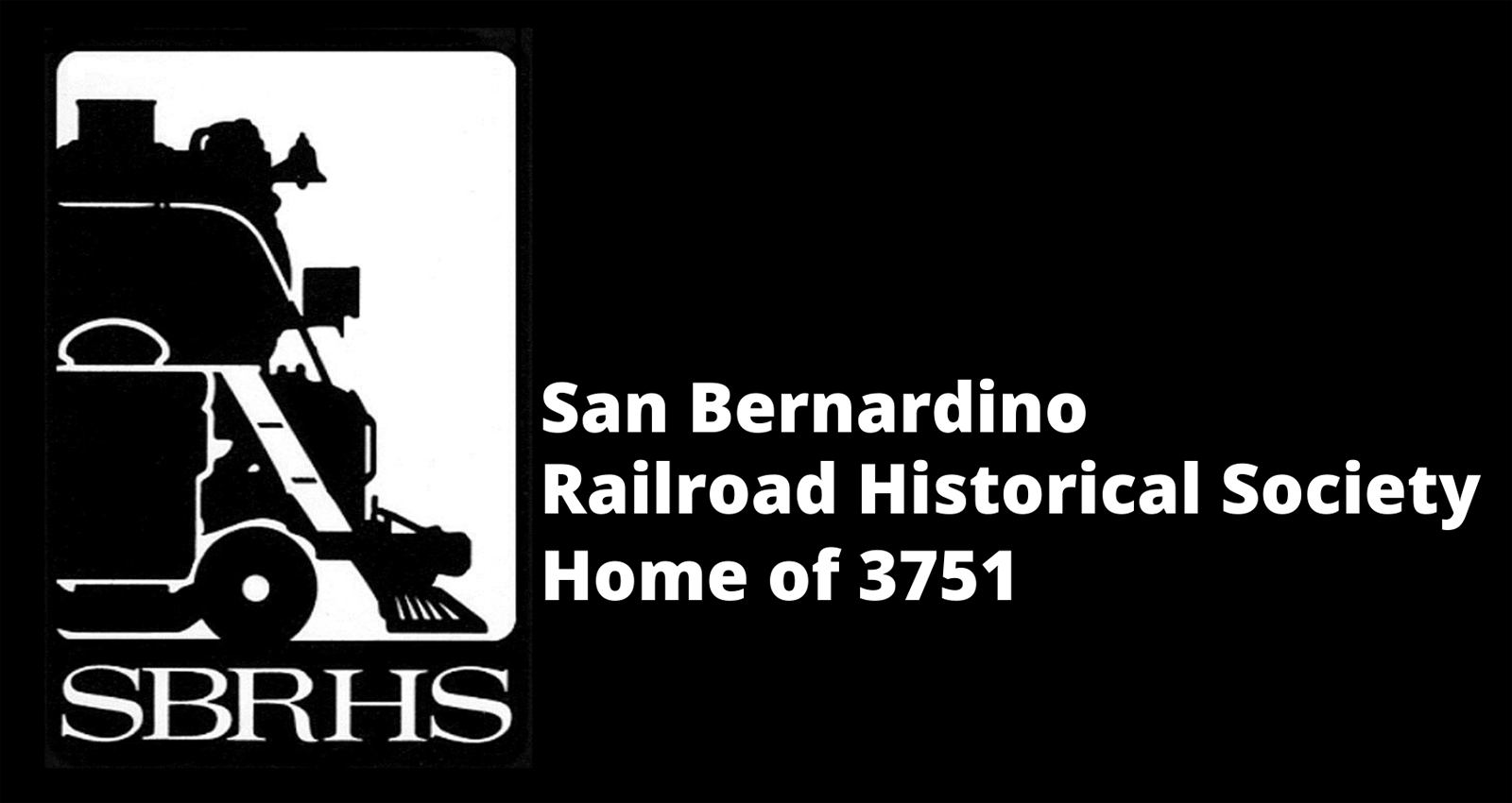Restored with pride. Operated with passion.

HISTORY OF SANTA FE 3751: A PIONEER 4-8-4
(Written by Lloyd E. Stagner)
The Atchison, Topeka & Santa Fe Railway during the administration of Edward H. Ripley (who oversaw its rebuilding during his 1895-1920 term as president) was a pioneer in the introduction of improved steam locomotives.
The AT&SF created the 2-10-2 wheel arrangement (appropriately named the Santa Fe type) in 1903 while the 4-6-2 Pacific was adopted almost simultaneously in 1903-1904. When passenger cars went to all-steel construction, necessitating heavier passenger power, the Santa Fe acquired two 3700 class 4-8-2 Mountain type engines in 1918. The evolution to 4-8-2’s occurred on the Santa Fe in 1927. In almost all these cases, the Santa Fe acquired the improved power years before other western railroads.

The AT&SF paid Baldwin Locomotive Works $99,712.77 for No. 3751, the thirteenth 4-8-4 of 892 constructed between 1926 and 1950 for U.S. railroads. A joint design effort of Santa Fe Mechanical Engineer Harold H. Lanning, his staff, and Baldwin, Santa Fe’s first 4-8-4 (and Baldwin’s first 4-8-4 as well) was a mixture of conservative design and the best locomotive technology of that time. Boiler pressure was set at 210 pounds, even though many engines had been set at 250 pounds since 1917. Modern features included cast steel cylinders keyed to the engine bed, front-end American multiple throttle, Elesco feedwater heater, Duplex stoker, Nicholson thermic siphons in the firebox (which had a large grate of 108 square feet) and the Type E high-temperature superheater.
Walschaert valve gear with a multiplying lever to provide 9” of maximum valve travel, operated with a Ragonnet power reverse gear, was provided. The Santa Fe’s own Layden exhaust nozzle was used as well. The tenders had a one-piece cast steel underframe, used six-wheel trucks, and held 15,000 gallons of water and 20 tons of coal. The 30”x30” cylinders resulted in high back-pressures at higher speeds, resulting in a decrease in the expected horsepower output. The 73” drivers were a good compromise for an engine used on both mountain and level territories, at a time when passenger train speeds seldom exceeded 65 miles per hour. The total engine weight of 421,000 pounds was only about four tons heavier than the heaviest 3800 class 2-10-2s but enough to make No. 3751 the largest engine on the system in 1927.
Tested against 4-8-2 No. 3714 between La Junta and Albuquerque, No. 3751 demonstrated savings of 19.4 percent in coal consumption while increasing water evaporation per pound of coal by 43.4 percent. It could handle 26 all-steel passenger cars on level track and 15 on two-percent grades. Maximum drawbar horsepower at 40 miles per hour was 3,220 with indicated or cylinder horsepower of 3,600 at that speed.
No. 3751 entered into passenger service on the difficult New Mexico division, with grades of 3.5 percent westbound and 3.3 percent grades eastbound over Raton Pass (where 2-10-2 helpers were employed). Performance as compared to the 4-8-2s was so strong that Santa Fe ordered nine additional 4-8-4s, Nos. 3752-3760, which were delivered in early 1928and four more, Nos. 3761-3764, followed in 1929.
The 14 engines were assigned to a La Junta-Winslow passenger pool, over 636.5 miles, with engines cutting out at Albuquerque for boiler wash and inspections when required. Five daily trains in each direction were handled, including the crack Chief, the all-Pullman California Limited, the Fast Mail Express, the Grand Canyon Limited, and the Navajo. Depression-era reductions in passenger train mileage saw four trains each way via La Junta, making the 4-8-4s available for trains No. 9 and No. 22 between Winslow and Clovis, 503.5 miles.
The May 1936 inauguration of the diesel-powered Super Chief and the need for relief steam power put No. 3751 in the San Bernardino shop for conversion to burn oil, which was completed in December of that year. A 5,071 gallon oil tank was fabricated for the coal compartment in the tender and the engine was assigned to operate between Winslow and Los Angeles. On the days that the weekly Super Chief operated, No. 3751 was held at one intermediate engine terminal for possible relief. Through engine runs were established between La Junta and Los Angeles effective December 7, 1937; No. 3751 was put on this run, alternating with 11 new 4-8-4s (Nos. 3765-3775) when they were delivered beginning in April 1938. This 1,235-mile run was the longest steam engine assignment in the country at that time.
In 1938 the Santa Fe began an upgrading program on ten of the fourteen 4-8-4s. New 80-inch Boxpok driving wheels were applied, along with Timken roller bearings on all engine axles. The Elesco closed type feedwater heaters were replaced with Worthington 6-SA open type on the last four engines, which were out shopped at Albuquerque during 1941. No. 3751 was the next to last to be improved, leaving the shop on August 30. With steam pressure raised to 230 pounds, the maximum drawbar horsepower was 3,600 at 50 miles per hour, with 3,900 indicated horsepower at that speed. Increasing the size of the steam passages to and from the cylinders overcame part of the high back-pressure problem of the engine as built. A maximum speed of 90 miles per hour was permitted with the rebuilt engines, although documentation shows that No. 3751 exceeded 100 miles per hour several times.
The original 4-8-4s had been handling the Grand Canyon Limited between Los Angeles and Wellington, Kansas (1,534 miles) since January 1940; upon completion of its rebuilding, No. 3751 entered this pool. Operating requirements sometimes saw No. 3751 on a La Junta-bound train out of Los Angeles, but after delivery of the 10 newest 4-8-4s, Nos. 3776-3785, in the summer of 1941, this became less frequent. Effective May 23, 1942, the original 4-8-4s started running through from Los Angeles to Kansas City via Amarillo, a distance of 1,789 miles, setting a new record for through steam locomotive runs. During World War II, these engines handled both the Scout and the Grand Canyon Limited. On-time performance was not the best with long stops to work heavy mail and express, but seldom was one of these engines cut out at an intermediate terminal due to failure. During the typical month of August 1943, the 14 engines averaged 18,435 miles per locomotive with a repair cost of 23 cents per mile at a time when 3,600-horsepower diesels handling lightweight trains cost 32.4 cents a mile for repairs.

The larger 2900 class 4-8-4s, built in 1943-1944, were assigned to the Scout and Grand Canyon Limited on September 23, 1945 when the end of the war permitted them to be spared from freight work. New passenger diesels started arriving in the fall of 1946, displacing the 10 original 4-8-4s to freight service West out of Argentine yard in Kansas City. They primarily ran to Waynoka, Oklahoma and sometimes through to Clovis, New Mexico, a 637 mile district. No. 3751 retained its status as a passenger engine and was assigned to the Arizona division on trains No. 23 and No. 24, the Oakland section of the Grand Canyon between Barstow and Bakersfield, over the Tehachapi Mountains. Height restrictions at the numerous tunnels on this route resulted in the extension smokestack being replaced with a lower deflector type.

In 1950, No. 3751 was equipped with automatic train-stop equipment. That year also saw the last class 3 general overhaul for No. 3751 at Albuquerque; upon its release, it was assigned to the Los Angeles division. Working out of the Redondo Junction roundhouse, No. 3751 protected extra sections and special trains to Barstow, served as passenger helper out of San Bernardino, and handled the Del Mar Race Track trains and locals 75-70 between Los Angeles and San Diego. When a diesel was out of service, the 4-8-4 would handle the streamlined San Diegan trains, on time to boot. Class 5-H repairs were made at Albuquerque in December 1951 and December 1952, and upon its return to Los Angeles, No. 3751 ran 3,954 miles in January and February 1953. March through June saw it stored serviceable, but the pioneer 4-8-4 was returned to service in July to assist in a heavy movement of special trains to and from the Boy Scouts’ encampment at Santa Ana. After covering 5,319 additional miles, it was laid up at Redondo Junction on August 23, 1953. A 26-year career as a passenger locomotive was finished. Always dependable, No. 3751 didn’t owe “Uncle John” a dime when it finished its last mile in regular service.

